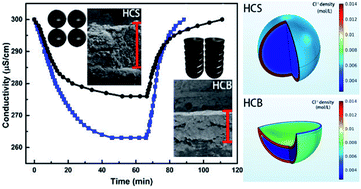An ion-accumulating effect in a hollow carbon bowl electrode: understanding the structure-enhanced volumetric desalination capacity and ion transport kinetics in capacitive deionization†
Abstract
Capacitive deionization (CDI) is an energy-efficient and eco-friendly technology for purifying waste water. However, enhancing the volumetric desalination capacity and rate capability, based on a rational design strategy and deep understanding of the structure–performance relationship of electrode materials, remains a huge challenge. In this work, a hollow carbon bowl (HCB) was prepared as an advanced electrode material for CDI applications. The HCB electrode exhibits a superior volumetric desalination capacity (SACV) of 3.6 mg cm−3 and a fast salt-removal rate with a gravimetric desalination capacity (SACG) of 21.8 mg g−1. Combining the experimental results and finite element simulations, we demonstrate that the obtained promising CDI performance of the HCB is attributed to its structural merits, where the small cavities of the HCB efficiently increase the packing density of electrodes and the ultra-thin carbon shells of the HCB substantially facilitate ion transport. This work paves a way for miniaturizing future CDI devices based on developing structure-enhanced electrodes with high volumetric desalination capacity and fast ion transport kinetics.



 Please wait while we load your content...
Please wait while we load your content...